Fogo Island, known as Djarfogo by its inhabitants, is a true spectacle of natural beauty that captivates the senses. With its towering volcano dominating the landscape and its rugged terrain challenging adventurers, Fogo Island offers much more than breathtaking views. It invites visitors to immerse themselves in authentic experiences, from trekking to exploring the island’s local culinary delights.
In Part 1 of this article, you’ll discover two of the six most beautiful natural wonders and learn what you can do and see beyond just admiring its dramatic landscapes. The rugged terrain and rich soil of Fogo Island not only produce spectacular scenery but also vibrant wines and coffee with an irresistible aroma.
At the end of this article, you can click to read Part 2 and discover the remaining four natural wonders of Fogo Island!
#1 Natural Wonder of Fogo Island: the unmissable Fogo Volcano
The imposing Fogo Volcano, the highest point in Cape Verde, is not just a natural wonder but also the centre of vibrant geological activity. Its last eruption in 2014 transformed the landscape and attracted scientists, researchers, and tourists from around the world. Despite remaining active, the volcano poses no threat to visitors.
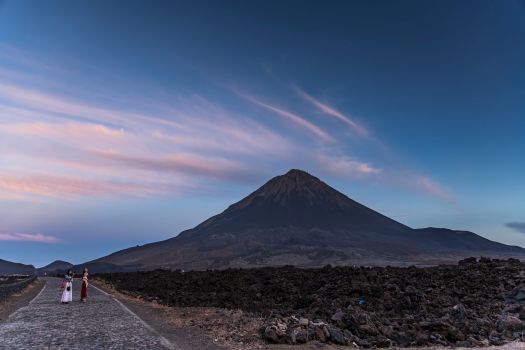 The entire surroundings of Fogo Volcano are an invitation to discovery.
The entire surroundings of Fogo Volcano are an invitation to discovery.
Standing 2,829 meters tall, the highest point of the volcano, the majestic Pico do Fogo, offers a challenge to trekking enthusiasts, attracting athletes from all over the world for competitions. Climbing Pico do Fogo not only provides stunning views but also offers a deep sense of freedom and accomplishment—an experience of a lifetime for many.
The slopes tell stories of both recent and ancient eruptions, with layers of solidified lava intriguing geologists and adventurers alike.
The fertile land nourishes a unique flora, hosting endemic species and making Fogo Island a renowned producer of coffee and wine, recognised and awarded internationally.
Near Fogo Volcano, you’ll find lava fields. Along the road, the lava flows from 1951, 1995, and 2014 lie in distinct tones: the more recent the flow, the darker the colour.
The entire area surrounding Fogo Volcano is an invitation to exploration—a perfect adventure for those who love to discover unique landscapes and connect deeply with the sights, sounds, and scents of extreme nature.
Fogo Natural Park: Cape Verde's largest protected terrestrial area
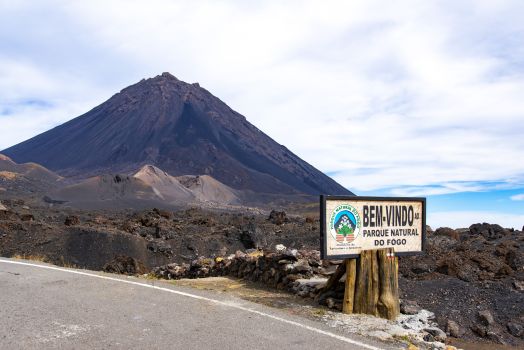 Fogo Natural Park impresses with its vastness
Fogo Natural Park impresses with its vastness
Fogo Natural Park is located in the island's central region and stretches across three municipalities: Santa Catarina, São Filipe, and Mosteiros. It is Cape Verde's largest protected terrestrial area, encompassing Fogo Volcano, the Bordeira, and Monte Velha Forest.
This park plays a crucial role in conserving local biodiversity and offers numerous trails for trekking enthusiasts.
Before venturing into Fogo Volcano, it’s recommended to visit the Fogo Natural Park headquarters in Portela, Chã das Caldeiras.
Equipped with advanced technology, the headquarters is powered by photovoltaic panels. Another interesting fact is that it is painted with a special graphene-based paint and micro glass spheres, providing thermal comfort year-round.
Here, travellers can access important information about Fogo Island and make use of public facilities.
Climbing the Volcano and exploring Fogo Island through its trails
Fogo Island features a series of well-marked, approved trails that vary in distance and physical demands. However, they all offer the opportunity to explore the island on foot.
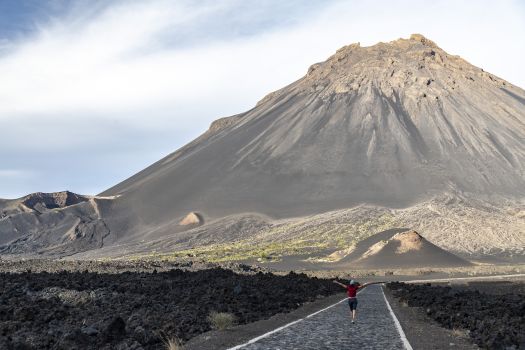 Some of the best athletes participate in Fogo’s trails.
Some of the best athletes participate in Fogo’s trails.
Walking these trails provides intimate contact with Fogo’s stunning natural landscapes and the abundance of life that thrives in its rich soil, from fruits to plants.
These trails also bring the chance to interact closely with the island’s inhabitants and understand the true meaning of "morabeza" (hospitality) through the constant kindness of a people who excel in welcoming visitors.
For some trails, it is advisable to have the company of a certified guide. For instance, the climb to Pico do Fogo and the Bordeira trail are not signposted, making a local Cape Verdean guide invaluable for experiencing this adventure.
While exploring, remember to minimise your impact: don’t write on the rocks or remove any materials from the volcano.
If you’re looking for a souvenir, local artisans craft volcanic stones into unique works of art. Buying a keepsake from them supports the local economy and helps preserve one of Cape Verde's greatest natural wonders.
#2 Natural Wonder of Fogo Island: the Bordeira that encircles the heart of the island
From an aerial view, Fogo Island is divided into the area outside the volcano crater, known as the Bordeira, and the inner part of the crater, the caldera, located within the Bordeira.
Surrounding the island’s heart, the majestic Bordeira, with its rocky cliffs and views of São Filipe, is a natural wonder formed by past volcanic activity.
The volcanic soils support rich and diverse agriculture, including the vineyards that produce Fogo Island’s famous "manecon" wine.
The green vegetation contrasts beautifully with the black soil, making it a photographer’s dream.
From its peak, you can see Santiago Island, with a landscape that stretches across the sea, blending geology with breathtaking scenery.
On the slopes of the Bordeira, you may spot the Cape Verde shearwater, an endemic bird species that nests there. These fast, agile fliers spend most of their lives at sea, making strategic stops between September and June for reproduction. Besides Fogo, you can also observe the shearwater on the islands of Santiago, São Nicolau, and Santo Antão.
Chã das Caldeiras: life close to the volcano
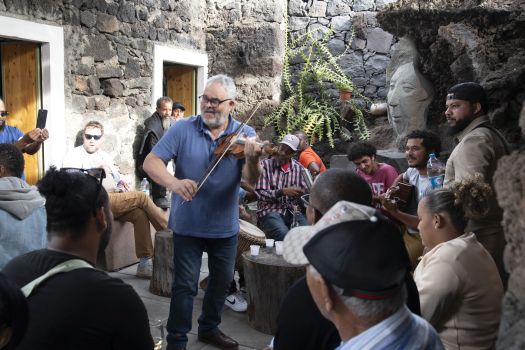 The joy and hospitality of Chã das Caldeiras are contagious
The joy and hospitality of Chã das Caldeiras are contagious
At the foot of Fogo Volcano, the community of Chã das Caldeiras is a unique testament to resilience, well worth a visit.
After being devastated by the lava flows from the last eruption in 2014, the community rebuilt itself: homes were reconstructed, and new farming methods were developed.
In the area surrounding Fogo Volcano, which includes the Bordeira, you’ll find some of Cape Verde’s most fertile land, abundant with fruit, vineyards, and coffee plantations.
Unique fruits with distinct aromas and flavours
The fertile soils, altitude, and trade winds make Fogo Island a paradise for orchards. Along with a wide variety of fruits, the island offers unique aromas and flavours.
As you hike along the trails of Fogo Island, you’ll likely encounter locals who may offer you a piece of fruit or even a taste of the island’s famous traditional wine, manecon.
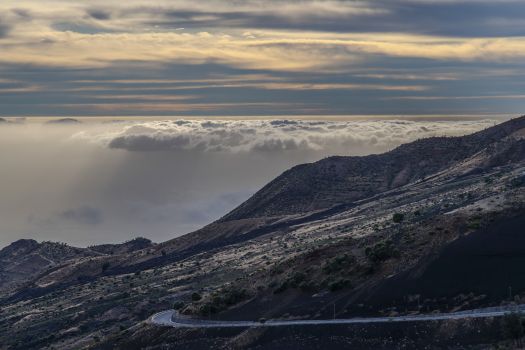 The vibrant green growth standing out against the dark volcanic slopes.
The vibrant green growth standing out against the dark volcanic slopes.
Fogo Wine: internationally recognised
Fogo wine, produced on the rich volcanic slopes, is renowned for its unique origin. The mineral soil and special microclimate give this wine a rich flavour and aroma that delights even the most refined palates.
Enjoying this wine offers a true journey into Cape Verdean culture and tradition, making for an unforgettable wine experience.
The wines come from vineyards in Chã das Caldeiras, Achada Grande, and São Filipe, featuring varieties like red, white, rosé, and the amber passito, made from sun-dried Muscat grapes.
Fogo Island’s wineries—Adega de Chã, Adega Maria Chaves, and the Sodade winery/cooperative—are internationally recognised, producing award-winning wines such as “Chã Branco,” “Santa Luzia” (white), and “Pico do Fogo” (red reserve).
Make sure to try the traditional manecom wine, a robust local specialty, similar in taste to port wine.
Fogo coffee: aromatic and flavourful
Initially introduced at the Morgadio de Monte Queimado by Pedro Fidalgo Andrade, coffee has been a local economic pillar since the 18th century.
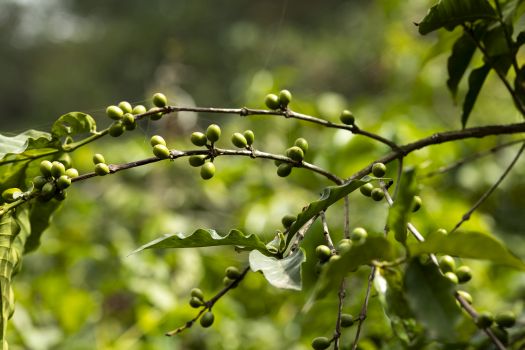 Take the opportunity to visit the coffee plantations!
Take the opportunity to visit the coffee plantations!
Today, the Arabica variety is cultivated on the steep slopes of Mosteiros municipality, at altitudes ranging from 350 to 1,300 meters.
This peculiar microclimate favours an exceptionally high-quality harvest, distinguished by its intense aroma. The peak production period occurs between February and March.
After harvest, the beans are sun-dried and then processed, either by modern machines or traditional methods, preparing them for roasting. This coffee is 100% organic, and tasting it is an unmissable experience.
If you're a coffee and culture lover, why not visit the Coffee Museum in Mosteiros?
This beautiful space promotes coffee tourism and offers dynamic insights and experiences.
Want to know the remaining 4 Natural Wonders of Fogo Island? Read Part 2 of this article or click here to Discover Fogo Island
Sources:
Catalogue of Cape Verde's Natural and Territorial Heritage.





